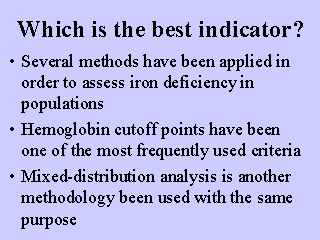|
|
|
|
front |1 |2 |3 |4 |5 |6 |7 |8 |9 |10 |11 |12 |13 |14 |15 |16 |17 |18 |19 |20 |21 |22 |23 |24 |25 |26 |27 |28 |29 |30 |31 |32 |review |
 |
Several methods have been applied in order to assess iron deficiency
in populations, showing different results in terms of identifying
the true anemic group. This is related to the variability of some of
the measurements even in normal subjects, and that each determination
is related to different stages of iron deficiency. Two approaches applied on assessing ID must be clarified: the cutoff point and the mixed distribution analysis. Hemoglobin cutoff points have been one of the most frequently used criteria, but the usefulness of this method is limited due to the variability of hemoglobin values in normal subjects. Based on the concept of mixed distribution, the use of cutoff point approach, a commonly used one, sensitivity, specificity and positive predictive value will depend on the cutoff point applied and the prevalence of IDA in the population. |